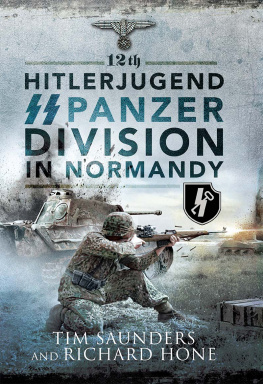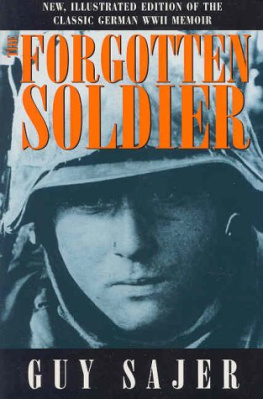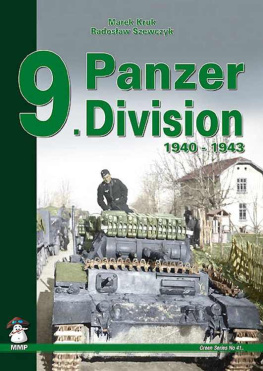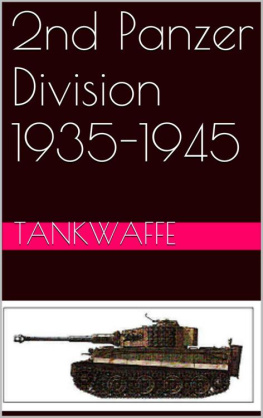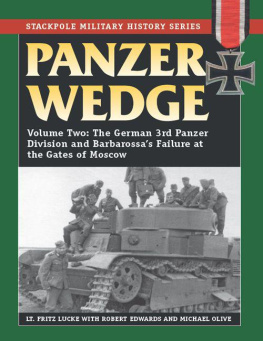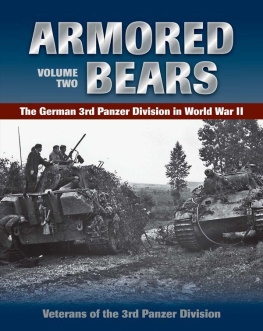9th Panzer Division 1941-1945
Here you can read online 9th Panzer Division 1941-1945 full text of the book (entire story) in english for free. Download pdf and epub, get meaning, cover and reviews about this ebook. year: 2015, publisher: Castle Rock Publishing, genre: Non-fiction. Description of the work, (preface) as well as reviews are available. Best literature library LitArk.com created for fans of good reading and offers a wide selection of genres:
Romance novel
Science fiction
Adventure
Detective
Science
History
Home and family
Prose
Art
Politics
Computer
Non-fiction
Religion
Business
Children
Humor
Choose a favorite category and find really read worthwhile books. Enjoy immersion in the world of imagination, feel the emotions of the characters or learn something new for yourself, make an fascinating discovery.
- Book:9th Panzer Division 1941-1945
- Author:
- Publisher:Castle Rock Publishing
- Genre:
- Year:2015
- Rating:4 / 5
- Favourites:Add to favourites
- Your mark:
- 80
- 1
- 2
- 3
- 4
- 5
9th Panzer Division 1941-1945: summary, description and annotation
We offer to read an annotation, description, summary or preface (depends on what the author of the book "9th Panzer Division 1941-1945" wrote himself). If you haven't found the necessary information about the book — write in the comments, we will try to find it.
Unknown: author's other books
Who wrote 9th Panzer Division 1941-1945? Find out the surname, the name of the author of the book and a list of all author's works by series.
9th Panzer Division 1941-1945 — read online for free the complete book (whole text) full work
Below is the text of the book, divided by pages. System saving the place of the last page read, allows you to conveniently read the book "9th Panzer Division 1941-1945" online for free, without having to search again every time where you left off. Put a bookmark, and you can go to the page where you finished reading at any time.
Font size:
Interval:
Bookmark:
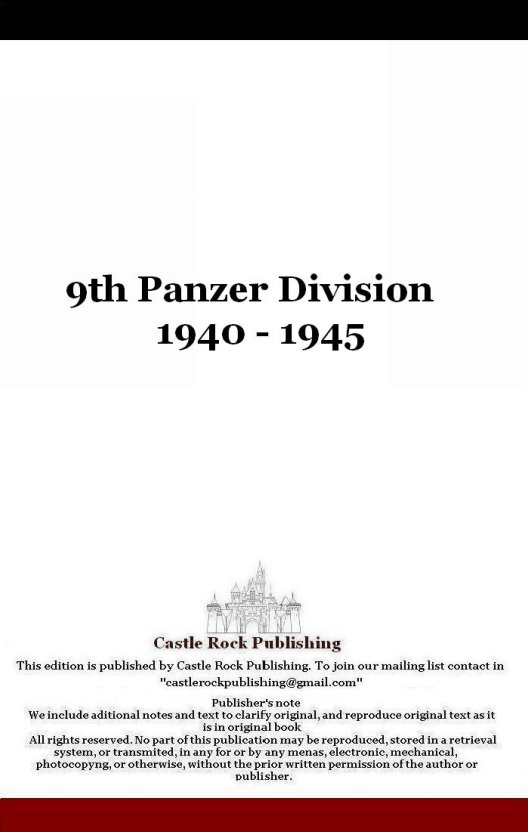
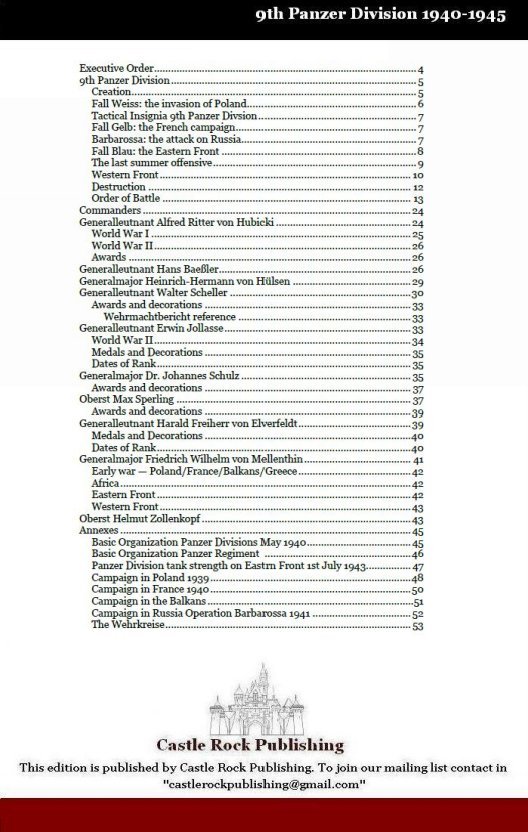
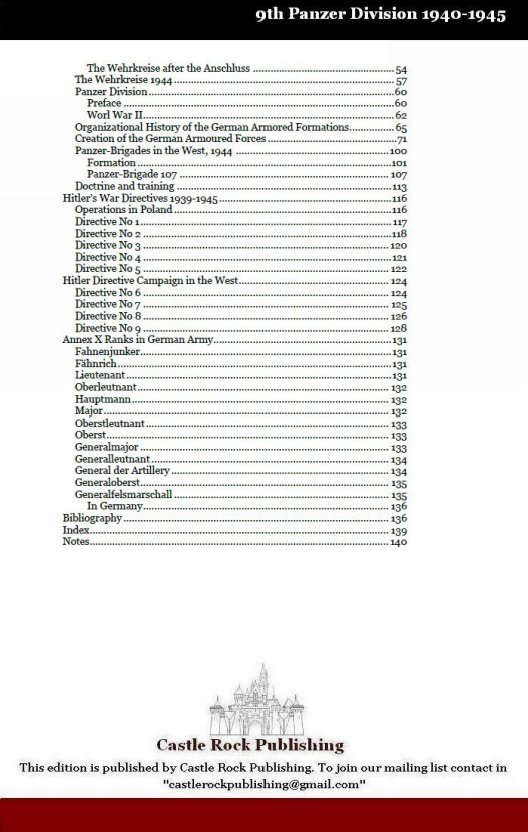
The Supreme Commander Berlin, 31.8.39
of the Armed Forces
OKW/WFA Nr. 170/39 g.K. Chefs. LI
Top Secret
Directive No. 1 for the prosecution of the war
1. Having exhausted all political possibilities of rectifying the intolerable situation on Germany's eastern frontier by peaceful means, I have decided to solve the problem by force.
The attack on Poland is to be carried out in accordance with the plans laid down for Case White, as modified by the fact that meanwhile the army has almost completed its deployment.
Allotment of tasks and operational objectives remain unchanged. Date of the attack 1 September, 1939.
Hour of the attack 04.45 hrs.
This hour applies equally to the launching of the operations Gdynia-Gulf of Danzig and Dirschau Bridge.
In the West the problem is unambiguously to saddle England and France with the responsibility for opening hostilities. Any insignificac: violation of the frontier is for the time being only to be dealt with purdy by means of local counter-measures.
We have guaranteed the neutrality of Holland, Belgium, Luxembourg and Switzerland and their neutrality is to be strictly observed.
At no point is the western land frontier of Germany to be crossed withe my explicit approval.
At sea this also applies to all warlike actions, or actions that might be construed as warlike.
The defensive measures of the air force are for the time being to consis: solely in repelling enemy air attacks within the borders of Germany; so far as possible the frontiers of neutral states are not to be crossed when repell^ attacks by single aircraft or by small formations. Only in the event of larsr formations of French and English aircraft flying across neutral states towards German territory and thus endangering our western air defences will ow defensive forces be free also to fly over neutral soil.
It is particularly important that the OKW be informed with all speed n the event of our Western enemies violating the neutrality of any other country.
If England and France open hostilities against Germany it is the task of those elements of the armed forces operating in the West by the employee* of minimum forces to ensure the maintenance of conditions which permit a victorious conclusion to the operations against Poland. As of this task maximum damage is to be inflicted on the enemy forces on his sources of economic strength. I retain in all cases the right to decide when offensive operations may be initiated.
The Army will hold the West Wall and will take the necessary steps to prevent it from being outflanked to the north by means of a violation of Belgian or Dutch territory on the part of the Western Powers. Should French forces move into Luxembourg the army is authorised to blow the frontier bridges.
The Navy will start warfare against commercial shipping, with main effort directed against the shipping of England. To increase the effectiveness of this warfare it may be assumed that certain zones will be declared danger zones. The Naval High Command (OKM) will report what sea areas may usefully be designated danger zones and to what extent. The text of such declarations will be prepared in conjunction with the Foreign Ministry and will be submitted to me, through the OKW, for approval.
The Baltic is to be made safe against enemy penetration. The OKM will decide whether for this purpose the entrances to the Baltic should be closed by minefields.
The Air Force has the primary task of preventing any operations by the French or English air forces against the German army or German territory.
In connection with the war against England, the Air Force is to prepare to interrupt England's seaborne supplies, armament industries and troop transports to France. Favourable opportunities for effective attack on massed units of the English fleet, in particular on battleships and aircraft carriers, are to be exploited. I retain the right of decision concerning attacks on London.
Attacks against the English home territories are to be prepared with this in mind: inadequate success with limited force is in all circumstances to be avoided.
signed: A. hitler Distribution:
OKH......1st copy
OKM......2nd copy
OKL......3rd copy
OKW: Chief Armed Forces Command
Staff.....4th copy
Spare.....5th-8th copies
The last of the pre-war Leichte divisions to be brought up to full Panzer Division status, the 9th Panzer Division came into existence on 1 March 1940.
The 9th Panzer Division was a panzer division of the Wehrmacht Heer. The division was only active during World War II, and came into existence after 4th Light Division was reorganized in January 1940. During its existence, the division was headquartered in Vienna, in the German military district Wehrkreis XVII.
Originally raised from Austrian forces annexed into Germany during the war, the 9th Panzer Division was part of most of the German Army's early Blitzkrieg attacks into western Europe. Sweeping east, the division was then a component of Operation Barbarossa, the German attack on the Soviet Union, where it was badly mauled at the Battle of Kursk.
Returning to France to rebuild in 1944, the division was rushed to counter Operation Overlord. It was destroyed several successive times by British and American forces as the German Army was pushed back across Europe. The division suffered massive casualties in armor and personnel until it finally collapsed in March 1945. The division's few survivors were pushed into the Ruhr Pocket where they surrendered to the Allies at the end of the war.
the 4TH leichte division was formed at Vienna on 1 April 1938, soon after the Anschluss between Austria and Germany. Manpower was provided by the former Austrian army. In March 1939, it took part in the occupation of Czechoslovakia. As with the other Light divisions, its fighting strength was provided by two motorized infantry regiments and a single understrength Panzer battalion, the 33rd.
1 september 1939
With just 57 fighting tanks, the 4th Light Division was the weakest armoured formation that took part in the German invasion of Poland in September 1939.
THE INVASION OF POLAND saw the 4th Light Division assigned to XVIII Army Corps of General List's 14th Army, part of Army Group South. On 19 August, the division received its war orders to move to forming up points in the Tatra Mountains.
Commanded by General der Panzertruppen Dr. Alfred Ritter von Hubicki, 4th Light was part of the drive to encircle and defeat the Polish Krakow Army, a mission that was completed in just over a week. At
the end of the campaign the Division was located at Tomaszow, facing westward after outflanking the Poles.
The Division remained in Poland until 25 October, when it returned to Germany. On 3 January 1940, the Division was reorganized and upgraded to become the 9th Panzer Division.
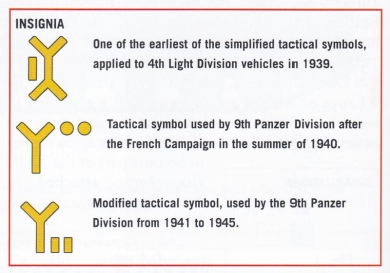
Font size:
Interval:
Bookmark:
Similar books «9th Panzer Division 1941-1945»
Look at similar books to 9th Panzer Division 1941-1945. We have selected literature similar in name and meaning in the hope of providing readers with more options to find new, interesting, not yet read works.
Discussion, reviews of the book 9th Panzer Division 1941-1945 and just readers' own opinions. Leave your comments, write what you think about the work, its meaning or the main characters. Specify what exactly you liked and what you didn't like, and why you think so.




